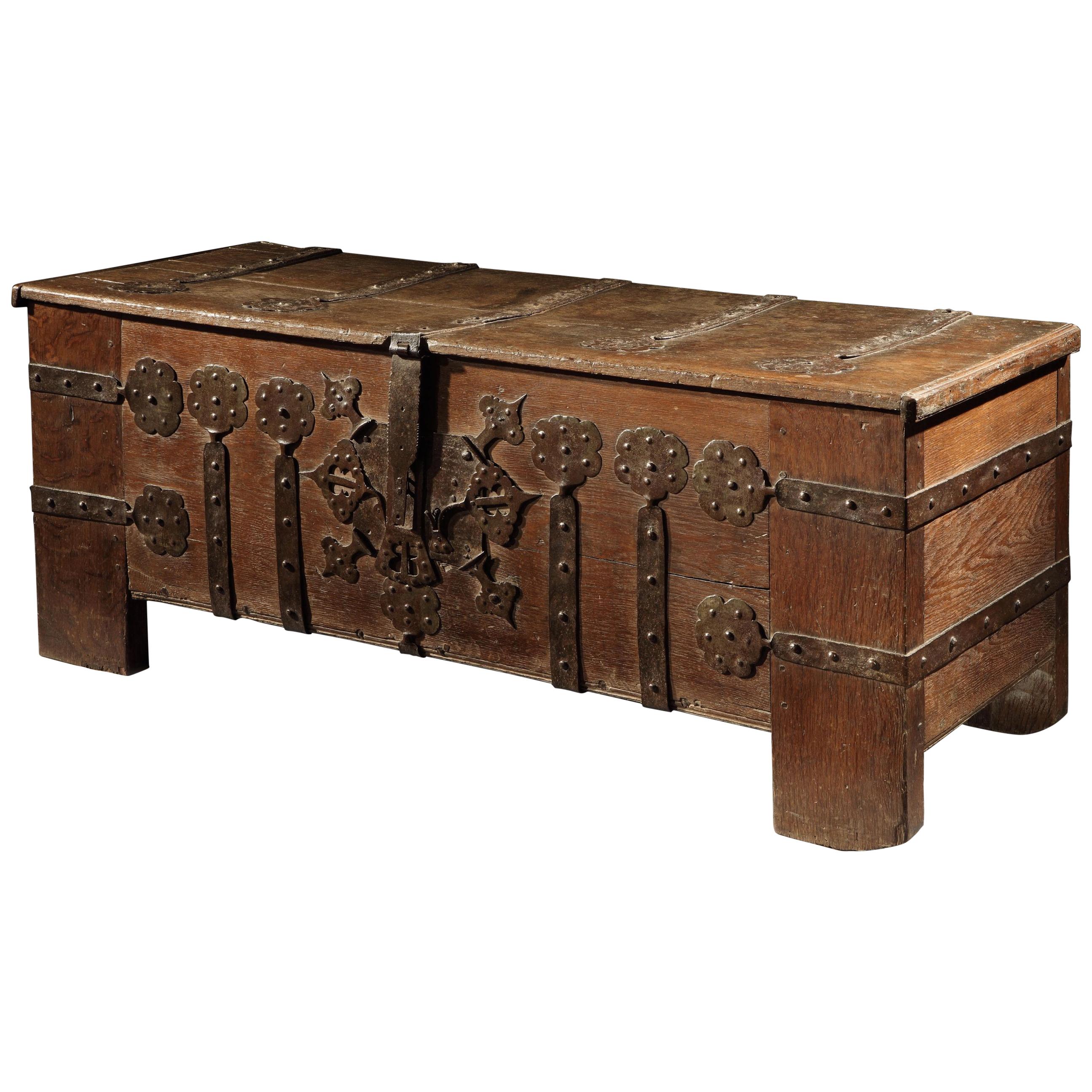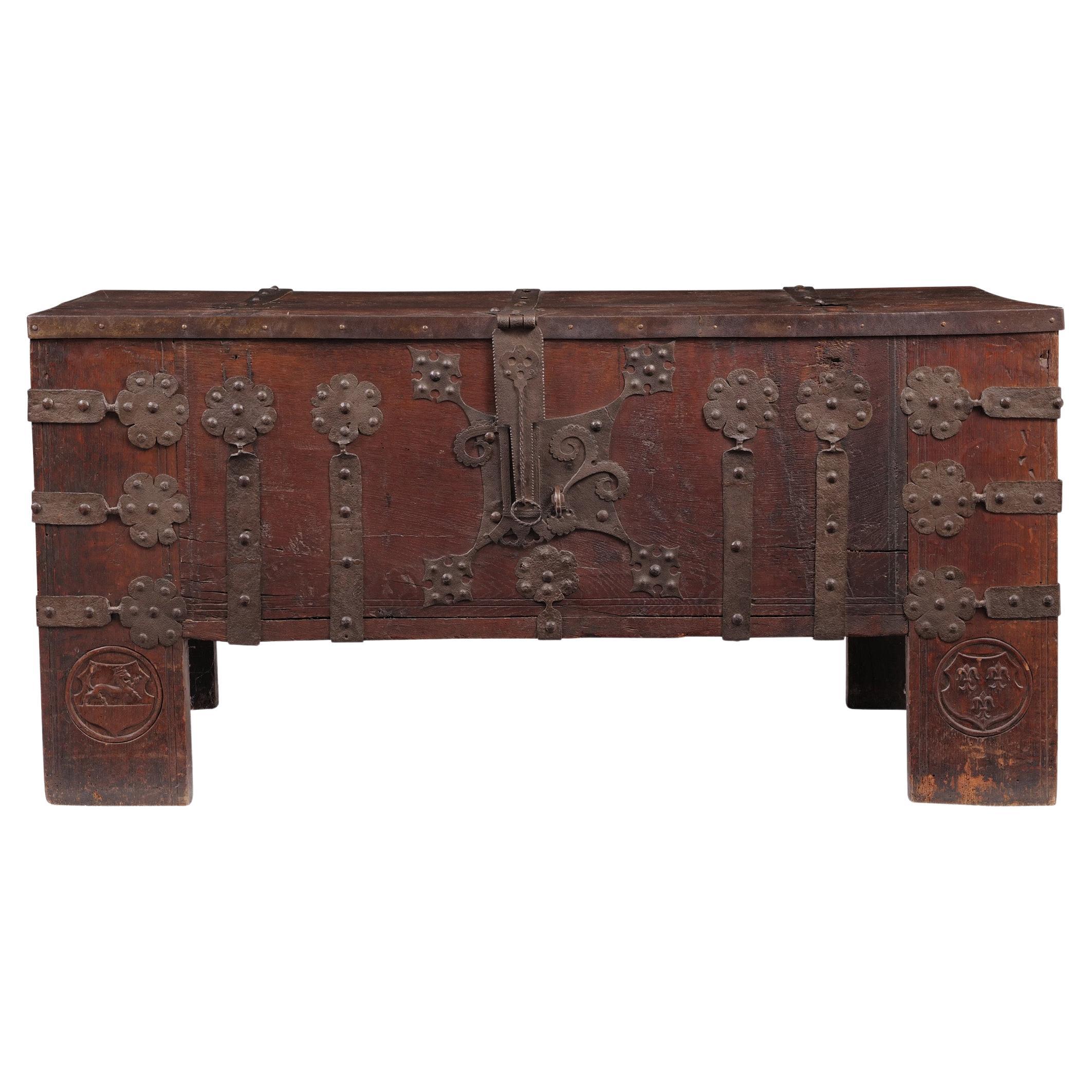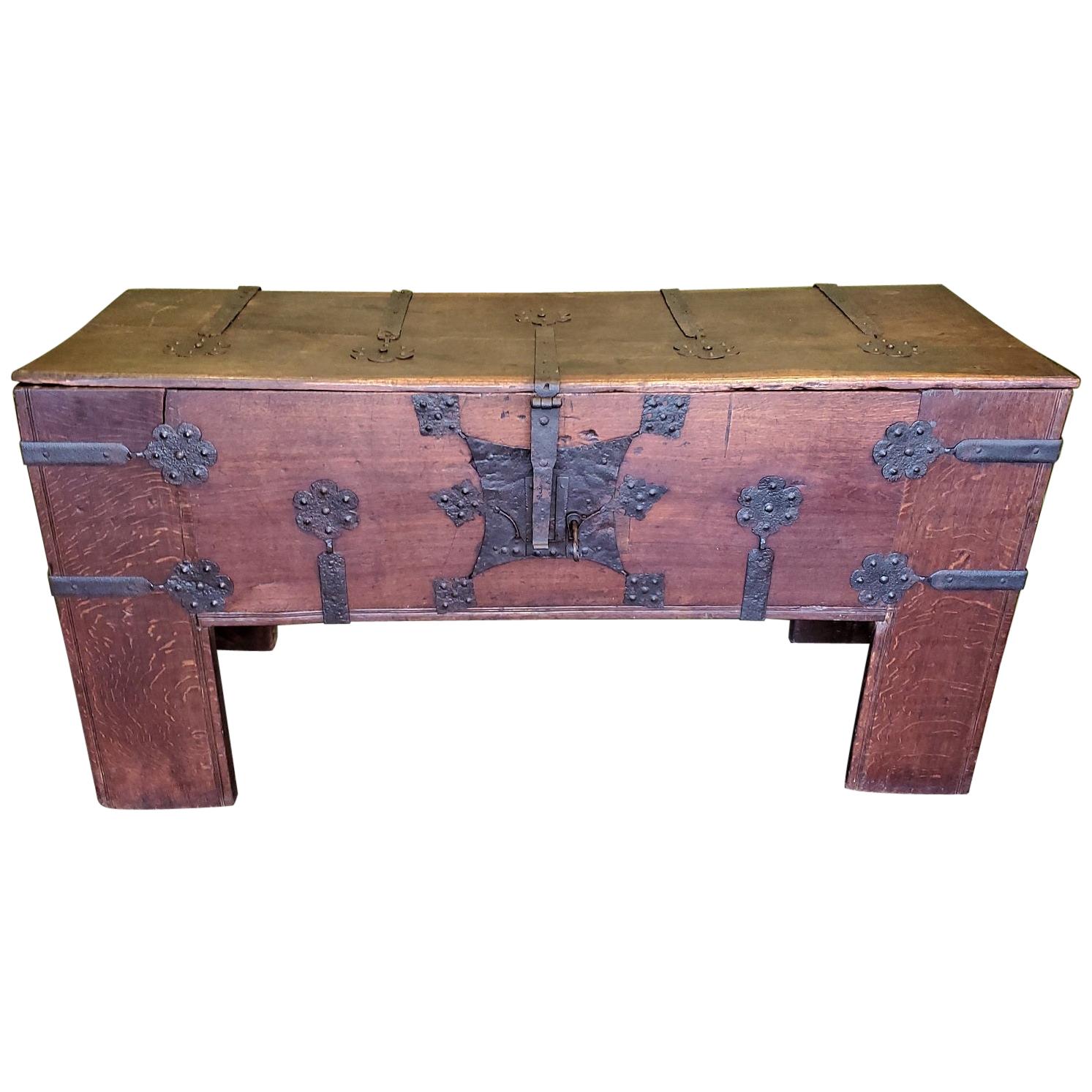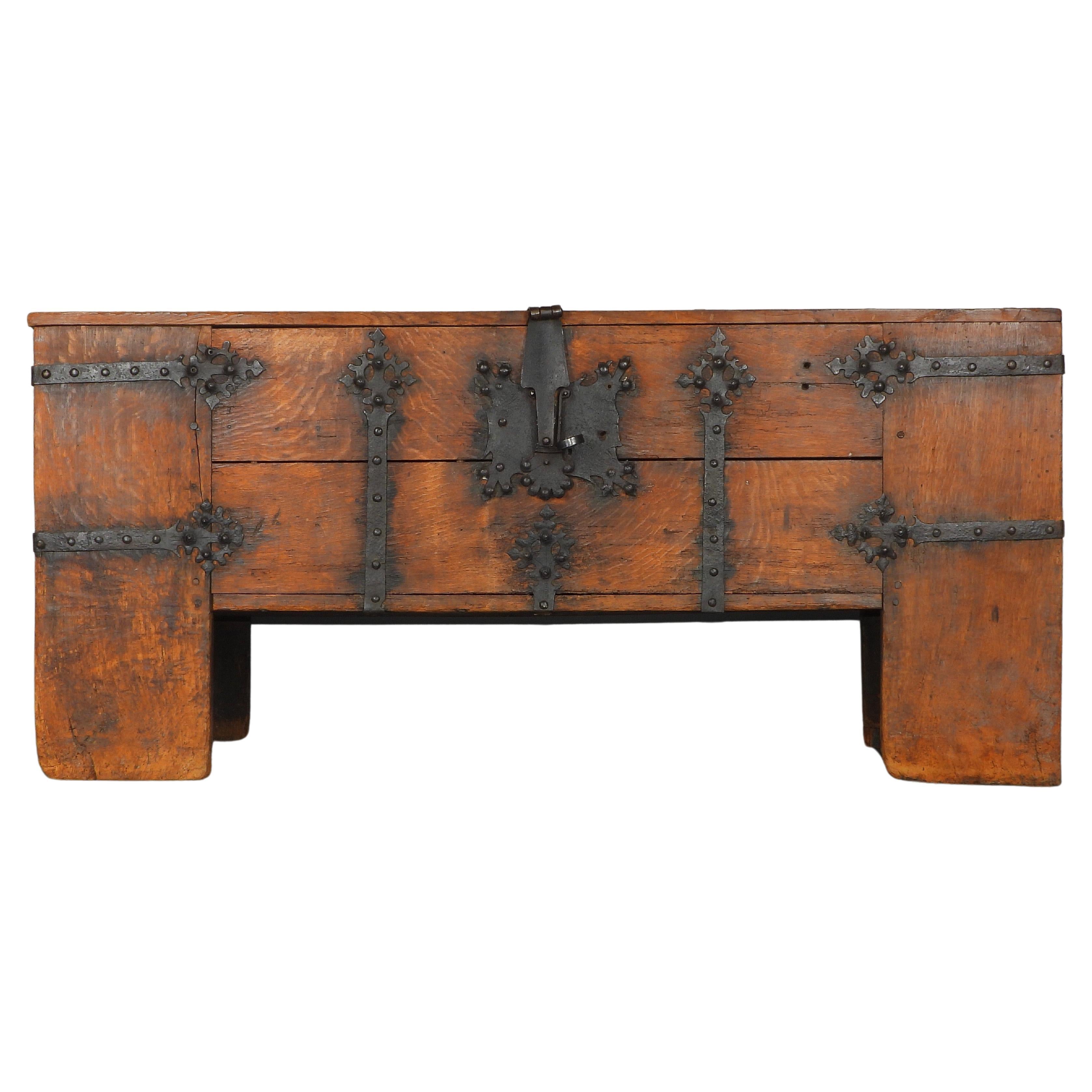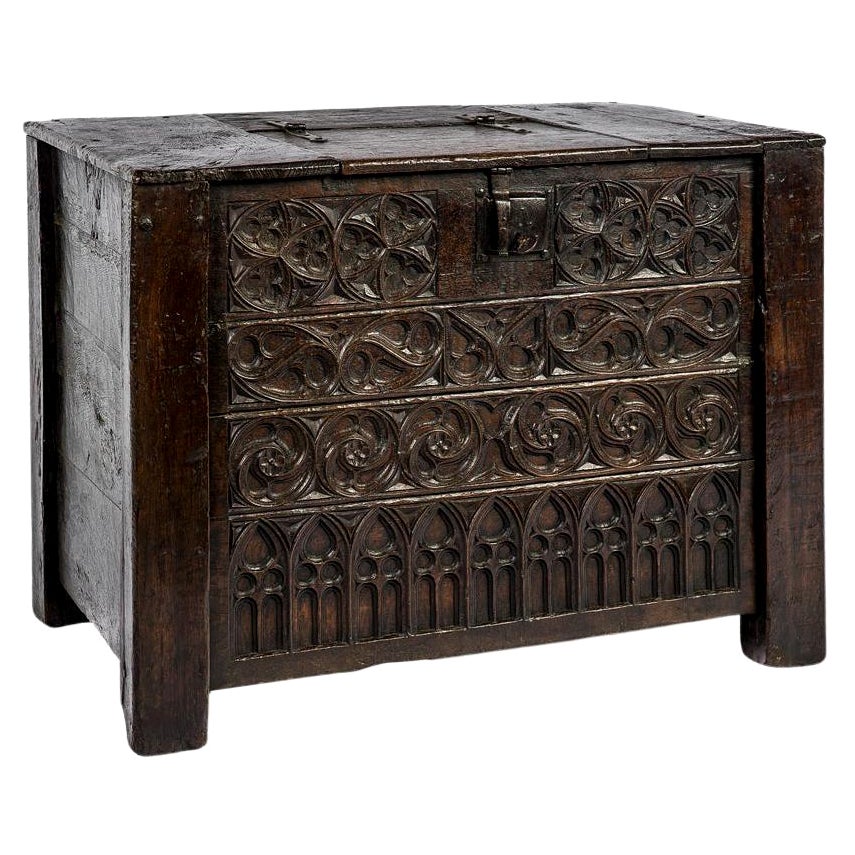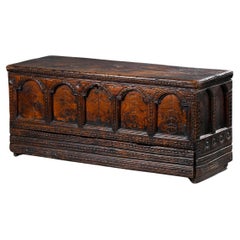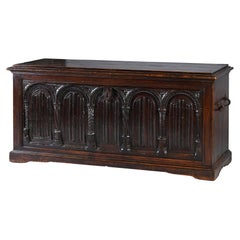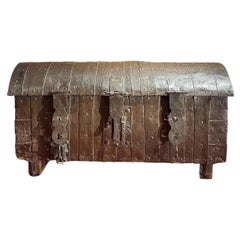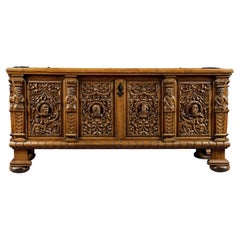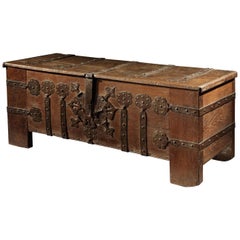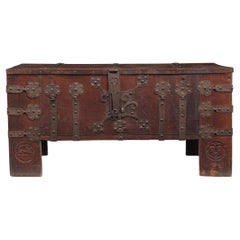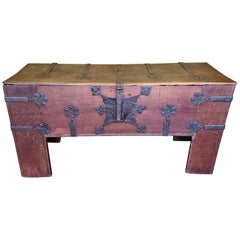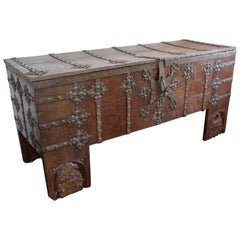Items Similar to Rare Gothic German Oak and Iron Chest Known as "Stollentruhe"
Want more images or videos?
Request additional images or videos from the seller
1 of 5
Rare Gothic German Oak and Iron Chest Known as "Stollentruhe"
$53,898.29
£39,941.60
€45,000
CA$73,581.41
A$81,856.30
CHF 42,910.10
MX$1,000,264.05
NOK 546,406.59
SEK 514,366.21
DKK 342,626.04
Shipping
Retrieving quote...The 1stDibs Promise:
Authenticity Guarantee,
Money-Back Guarantee,
24-Hour Cancellation
About the Item
This large chest stands on high legs prolonging the lateral jambs. Presenting a sober and severe appearance the chest still belongs to the Medieval tradition. The piece is made from very high quality Hungarian wood.
The jambs are joined to the facade and the lateral sides thanks to pegged mortise and tenon securing a great stability and squareness between each parts. The upper lid is made of two joined parts and so is the facade.
The ironwork is present all over the surface of the chest and brings both an additional stability to the construction as well as a rich decor. The lid is secured with hinges. Hinges also run all over the chest in horizontal and vertical lines, ending in a floral motif. The hasp lock is also very ornamental.
Those chests always present important proportions especially when they are made early in the period. This model was very popular in Germany and stayed in vogue until the 16th century. However the feet Gothic decor – vegetal scroll with a thistle and a fruit – allows us to date this chest from the late 15th century.
This chest can be compared to a similar chest kept in the collections of Heidelberg Kurpfalziches Museum.
Chests from this period are extremely rare and this one is extraordinarily well preserved.
- Dimensions:Height: 36.23 in (92 cm)Width: 68.9 in (175 cm)Depth: 24.41 in (62 cm)
- Style:Gothic (Of the Period)
- Materials and Techniques:
- Place of Origin:
- Period:
- Date of Manufacture:Late 15th Century
- Condition:Wear consistent with age and use. Minor losses. Minor structural damages. Minor fading.
- Seller Location:Saint-Ouen, FR
- Reference Number:1stDibs: LU3115327232852
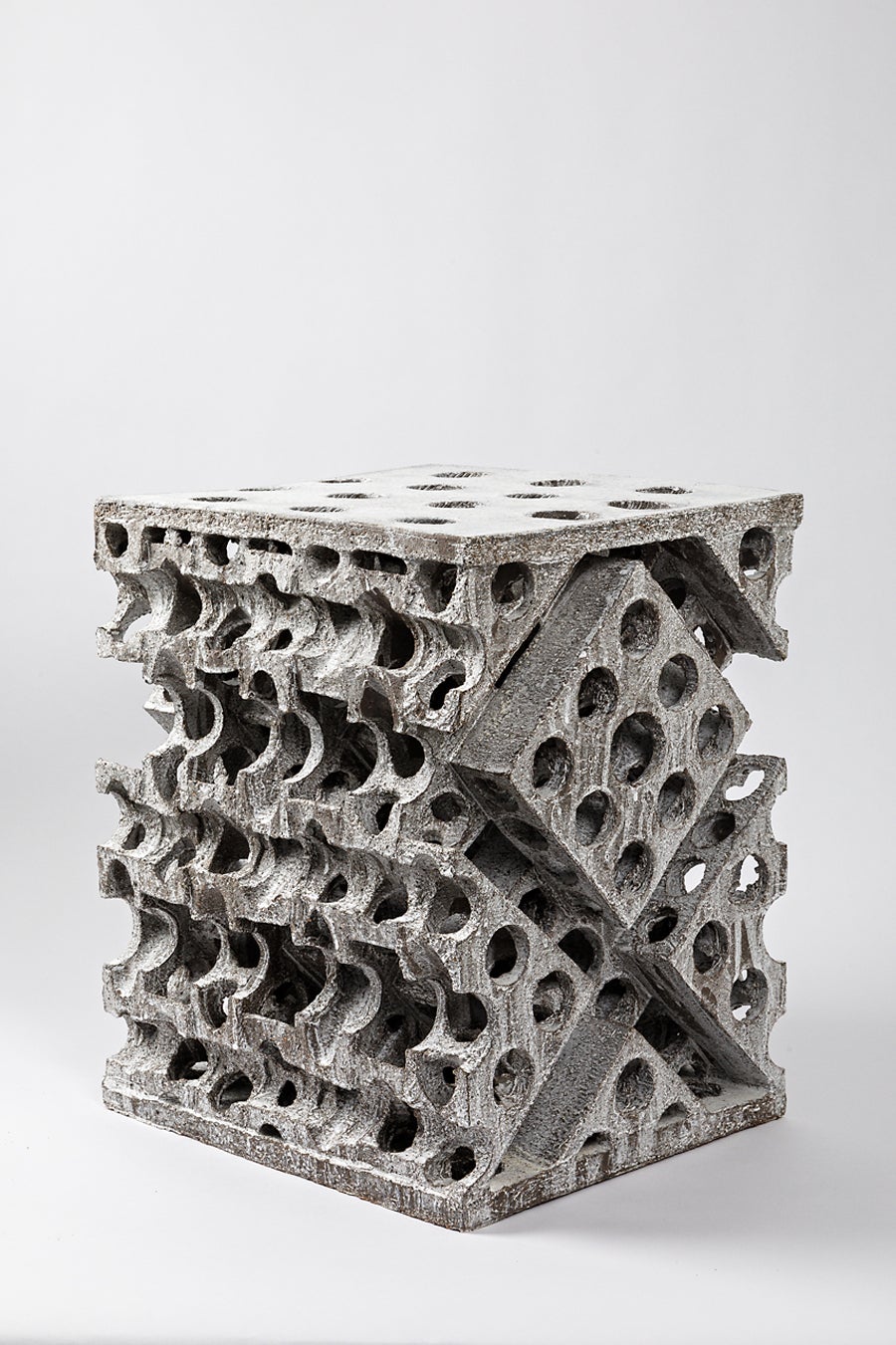
About the Seller
5.0
Vetted Professional Seller
Every seller passes strict standards for authenticity and reliability
Established in 2016
1stDibs seller since 2017
189 sales on 1stDibs
Typical response time: 3 hours
- ShippingRetrieving quote...Shipping from: Saint-Ouen, France
- Return Policy
Authenticity Guarantee
In the unlikely event there’s an issue with an item’s authenticity, contact us within 1 year for a full refund. DetailsMoney-Back Guarantee
If your item is not as described, is damaged in transit, or does not arrive, contact us within 7 days for a full refund. Details24-Hour Cancellation
You have a 24-hour grace period in which to reconsider your purchase, with no questions asked.Vetted Professional Sellers
Our world-class sellers must adhere to strict standards for service and quality, maintaining the integrity of our listings.Price-Match Guarantee
If you find that a seller listed the same item for a lower price elsewhere, we’ll match it.Trusted Global Delivery
Our best-in-class carrier network provides specialized shipping options worldwide, including custom delivery.More From This Seller
View AllSpanish Chest with Arcade design
Located in Saint-Ouen, FR
SPANISH CHEST WITH ARCADE DESIGN
ORIGIN: SPAIN
PERIOD: LATE 15TH – EARLY 16TH CENTURY
DIMENSIONS:
Height: 61 cm
Length: 135 cm
Depth: 48 cm
Chestnut wood
Good condition
This H...
Category
Antique 16th Century Spanish Gothic Blanket Chests
Materials
Wood, Chestnut
Gothic Chest with linenfold panels
Located in Saint-Ouen, FR
GOTHIC CHEST WITH LINENFOLD PANELS
ORIGIN : ILE DE FRANCE
PERIOD : CIRCA 1500
Height : 78 cm
Length : 167 cm
Depth : 61 cm
Walnut
Simple in the structure, this chest ...
Category
Antique 15th Century and Earlier French Gothic Blanket Chests
Materials
Wood, Walnut
Exceptional Cathedral Chest
Located in Saint-Ouen, FR
EXCEPTIONAL CATHEDRAL CHEST
ORIGIN: GERMANY
PERIOD: 15th CENTURY
Height : 77 cm
Length : 147 cm
Depth : 58 cm
Perfect state of preservation
This rare Gothic Cathedral Chest with...
Category
Antique 15th Century and Earlier Blanket Chests
Materials
Iron
$41,920
Rare and Important German Renaissance Chest
Located in Saint-Ouen, FR
Oakwood
Original lock and key
This beautiful and robust chest stands on square feet ending in flattened buns. The base presents plain mouldings. The facade is divided in four panel...
Category
Antique 16th Century German Renaissance Blanket Chests
Materials
Wood, Walnut
Large 16th Century Tuscan Wedding Chest Called "Cassone"
Located in Saint-Ouen, FR
Large wedding chest in tinted and gilded walnut, the lid animated with a frieze of pearls, the sides with compartments, the belt decorated with gadroons. It rests on four claw feets.
Category
Antique 16th Century Italian Renaissance Blanket Chests
Materials
Walnut
Wooden Chest Carved with Two Crenellated Towers
Located in Saint-Ouen, FR
WOODEN CHEST CARVED WITH TWO CRENELLATED TOWERS
ORIGIN: SOUTH WEST OF FRANCE
PERIOD: 16th CENTURY
Height: 64,5 cm
Length: 124 cm
Depth: 53 cm
Chestnut wood
Good condi...
Category
Antique 16th Century Blanket Chests
Materials
Chestnut
You May Also Like
Chest or Stollentruhe, Early 16th Century, German Gothic, Oak Chest, Original
Located in BUNGAY, SUFFOLK
This standing chest is of clamp-front construction, extensively decorated with long, ironwork straps with quatrefoil finials which ‘wrap’ around it, and has an ornate, central lockplate, and front legs with full, height stiles. The ironwork straps and finials are fixed with convex, headed nails: running along the front, five long straps; the two side straps; and the five straps on the top. On the chest front, centrally placed, is a large, iron lockplate with four outer, radiating spade finals in each corner and three, superimposed spade finials (a symbol of nobility) which are pierced with the initials ‘BB’. The lockplate receives a corresponding, external hasp fitted to the lid. Below the floor of the chest, the two front stile legs retain most of their original height. The lid is supported by substantial iron strap hinges that extend right down the back of the chest. Inside the chest at the left end is a shallow, oak till.
Construction The chest is of joined, 'clamp-front' construction, reinforced by the nailed, iron mounts. In total it uses ten, oak boards which were riven and planed. The back and front are each formed from a large single plank held to the full height stiles by long, pegged tenons. The sides are also single boards joined into the stiles using long tenons held by dowels, and extend down below the chest bottom, concealing the ends of the bottom boards. The bottom consists of a single board cut into the sides and shallow rebates in the stiles. The front and back boards are dowelled into the bottom boards. The lid which overhangs the sides has a narrow cleat at each end, and consists of one wide plank which has bowed a little as a result of shrinkage.
Ironwork : The wrought ironwork straps, lockplate, hasp and lock all appear all appear to be early, and of the same original manufacture and are fixed with convex headed nails. There is mild dark staining of the oak around the iron mounts, possibly because of low tannin content in the oak.
Length 172 cm., 67 ¾ in., Height 71.5 cm., 28 ¼ in., Depth 63 cm., 24 ¾ in.,
Related to: No 900:2-1904 V&A Museum, London. Stadtmuseum Dusseldorf. Decorative Arts Museum Berlin. Museen Schleswig-Holstein & Hamburg. A related example featuring elaborately-carved feet and formerly in the Horsham Museum, West Sussex, sold at Christie's in 2010 for £97,250 and another example, again with carved feet sold at Sothebys in 2006 for £48,000.
Literature: A similar example is illustrated in H. Lüttgens, Alt- Aachener Wohnkultur; Ein Rundgang durch ein altes Aachener Haus im Wohnstil des 18. Jahrhunderts, Aachen, n.d., ill. 12, and another comparable iron-bound chests...
Category
Antique 16th Century German Gothic Blanket Chests
Materials
Oak
Gothic front gallery chest, Westphalia around 1500 - 1550, oak
Located in Münster, DE
Gothic front gallery chest, Westphalia around 1500 - 1550, wrought iron bands, boxy oak body, partially carved. Monumental star-shaped key plate with original key, feet on the front ...
Category
Antique 16th Century German Gothic Blanket Chests
Materials
Oak
$15,810 Sale Price
20% Off
Rare (Late Medieval) 16th Century German Wrought Iron Oak Chest or Stollentruhe
Located in Dallas, TX
WE HAVE THE PLEASURE TO PRESENT an Exceptionally Rare (Late Medieval) 16th Century German Wrought Iron Oak Chest or Stollentruhe.
This is an Early...
Category
Antique 16th Century German Gothic Blanket Chests
Materials
Wrought Iron
Rare Late Medieval 16th Century German Wrought Iron Oak Chest or Stollentruhe
Located in Worpswede / Bremen, DE
A very impressive Westphalian Gothic chest or ‚Stollentruhe’, Westphalia, Germany, circa 1500-1550. Wrought iron mounted oak, partially carved. The monumental rectangular standing chest with full-height stiles, extensively mounted with wrought ironwork straps terminating in quatrefoil finials which ’wrap’ around the chest edges. These are fixed with convex head nails. The ironwork with some remains of an originally red painted surface. In addition, running along the edges of the lid at the front and sides is a plain iron band, close-nailed. The feet of the two front legs are finely carved on the front face, in low relief with a rectangular arched ’panel’ depicting on the left a lion, on the right a dragon holding each a coat of arms.
Regarding the age of circa 500 years, this coffer is in exceptionally good condition, with only smaller restorations.
Comparative literature
• Baumeier, Stefan, Beschlagene Kisten; Die ältesten Truhen Westfalens, Essen, 2012.
• Falke, Otto von, Deutsche Möbel...
Category
Antique 16th Century German Medieval Blanket Chests
Materials
Iron
Rare Late Medieval 16th Century German Wrought Iron Oak Chest
Located in grand Lancy, CH
A very impressive Westphalian Gothic chest or ‚Stollentruhe’, Westphalia, Germany, circa 1500-1550. Wrought iron mounted oak, partially carved. The monumental rectangular standing ch...
Category
Antique 16th Century German Commodes and Chests of Drawers
Materials
Iron
Rare 15th Century Solid Oak Medieval Dutch Gothic Chest or Trunk
Located in Casteren, NL
A very rare chest that was completely made of solid oak from the Netherlands middle ages.
It is a joined chest with hand carved geometric gothic front panels. The ornaments used are typical Gothic ornaments such as trefoil, mouchette, and trace.
This diminutive chest was probably made in the 15th century Netherlands. It has the typical construction of very early European furniture as is also seen on the German Stollentruhe.
The chest has only a small lid with forged hinges...
Category
Antique 15th Century and Earlier Dutch Gothic Blanket Chests
Materials
Wrought Iron
$10,540 Sale Price
41% Off
More Ways To Browse
16th Century German
Antique German Chests
Chest Museum
German Oak Cabinet
Side Lock Chest
German Lock
Gothic Oak Cabinet
Chest With A Hinged Lid
15th Century Gothic
Antique Wrought Iron Hinges
Gothic German
16th Century Wood Chest
15th Century Oak
Blanket Chest With Legs
Antique Medieval Chest
Antique Hasp
Antique Hasp Lock
16th Century Oak Chest
